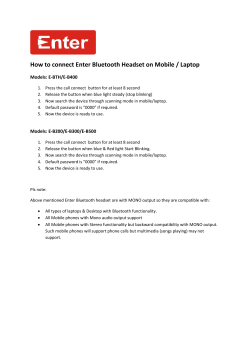
Trouble Shooting Jabra PRO 920 Changing the Channel
Trouble Shooting Jabra PRO 920 The circular dial with letters from A-G (but no F) on it, is what changes the frequency on which the telephone works. Changing the Channel on Your Jabra 920 Wireless Headset Look at the back of your headset. The circular dial with letters from A-G (but no F) on it, is what changes the frequency on which the telephone works. Most telephones get a clear dial tone on either channel A or G. Cisco is B. If you don’t have a dial tone, and you have power and your battery is fully charged, you have paired the unit to the base and also checked it isn’t in mute, try changing slowly through the channels until you hear a dial tone. Use the minus button twice in one second for mute, same action to turn mute off Using Mute There are three buttons on your headset. To turn mute on, press the middle button. It is slightly concave so you can find it quickly. A red led will light up on the bottom front of your headset base. To turn mute off press the same button again. Changing the Speaker Volume (speaker - the voice you hear) To change the speaker volume (this is the volume of the person’s voice on the other end of the phone) – press the minus (-) or plus (+) buttons on your headset. These are either side of the mute button. You can do this while someone is speaking and it won’t affect the conversation, except how loud their voice is. Changing the Microphone Volume (if too loud your voice will echo either for yourself or the other person) Look at the back of your headset and you will see two buttons next to the channel dial. They have plus (+) and minus (-) signs. Press the relevant button to turn your microphone volume up or down. If you hear an echo on the line or your colleagues do, you may have your mic volume too loud. Try turning it down a little, till there is minimal or no echo. Pairing Your PRO 920 Headset As long as your headset is set up correctly, the headset will pair with the base automatically when you place the headset in the charging cradle on the base - e.g. gently place the headset on the terminal to charge. Extra Info on Trouble shooting the 920 Can’t hear a dial tone – check cords are plugged in properly, is the power adapter unplugged? Check if the online indicator is lit – if not press the multifunction button on your headset. Check that the battery is charged (if it is charged the green led battery indicator on the front of the headset base/stand will be solid green) People can’t hear me properly – is mute on? The microphone boom arm may need to be in line with your mouth or closer. You could readjust your microphone volume. Or maybe you are out of range of the base unit (up to 120m) A crackle or buzzing sound – try moving your headset base about 30cm away from your telephone (radio transmission may be too close) This includes things like radios, stereos, ipods or any other electrical transmitting items. They should not be in the room if you are using a telephone headset and get interference. Serial numbers This is where to find the serial number - underneath your Jabra 920 wireless headset. This picture is the underneath of your 920 base unit. The serial numbers are on the barcode sticker on bottom of the base. This is the barcode sticker or serial no. This is the multi-function button Conferencing The Jabra PRO 920 is able to conference with four headsets in total - one primary and three secondary. Connecting a secondary during a conversation: While the primary headset is in use on the call, dock the secondary headset with the base hosting the call. When the headsets are successfully paired, a doubletone will sound in the primary headset. Tap the multi-function button on the primary headset to accept the secondary headset. The audio is now shared between the headsets. To end or leave the conference – the primary hedset user can end the conference by hanging up the call. The call is ended for all headsets. Guests can leave the conference by tapping the multi-function button on their headset, or by docking the headset with the hosting base. The conference call is still active for the other headset(s).
© Copyright 2025














